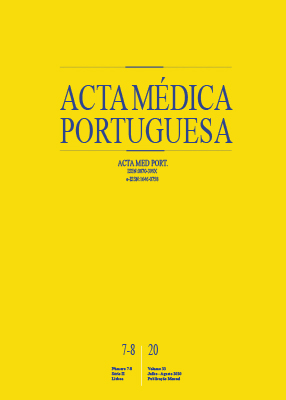Association between Serum Vitamin D and Diabetic Retinopathy in Portuguese Patients with Type 1 Diabetes
DOI:
https://doi.org/10.20344/amp.12890Keywords:
Diabetes Mellitus, Type 1, Diabetic Retinopathy, Portugal, Vitamin D, Vitamin D DeficiencyAbstract
Introduction: Recently, vitamin D has gained importance as a diabetes risk modifier. Our aim was to assess the association between serum vitamin D levels and the prevalence of diabetic retinopathy in patients with type 1 diabetes.
Material and Methods: Retrospective review of a population of patients with type 1 diabetes followed in a Portuguese tertiary center. Patients were included if they had an ophthalmological evaluation and a serum 25-hydroxyvitamin D level determination within the same year. Logistic regression analysis was used to adjust for possible confounders.
Results: We included 182 patients (47% male), and 57% (n = 103) had signs of diabetic retinopathy. We found a significant association between lower circulating levels of 25-hydroxyvitamin D levels and a greater prevalence of diabetic retinopathy after adjusting for confounders (duration of diabetes, estimated glomerular filtration rate, age, sex, metabolic control, season, dyslipidemia and hypertension) (OR = 0.94; 95% CI 0.90 - 0.99, p = 0.023). Longer duration of diabetes and worse metabolic control also remained associated with diabetic retinopathy in the multivariate analysis (OR = 1.20; 95% CI 1.13 - 1.27, p < 0.001 and OR = 4.13; 95% CI 1.34 - 12.7, p = 0.013, respectively).
Conclusion: Lower levels of vitamin D were associated with an increased prevalence of diabetic retinopathy in patients with type 1 diabetes, after adjusting for possible confounders. Future controlled studies may elucidate the molecular routes for this association as well as the role of supplementation in the prevention of diabetes microvascular complications.
Downloads
Downloads
Published
How to Cite
Issue
Section
License
All the articles published in the AMP are open access and comply with the requirements of funding agencies or academic institutions. The AMP is governed by the terms of the Creative Commons ‘Attribution – Non-Commercial Use - (CC-BY-NC)’ license, regarding the use by third parties.
It is the author’s responsibility to obtain approval for the reproduction of figures, tables, etc. from other publications.
Upon acceptance of an article for publication, the authors will be asked to complete the ICMJE “Copyright Liability and Copyright Sharing Statement “(http://www.actamedicaportuguesa.com/info/AMP-NormasPublicacao.pdf) and the “Declaration of Potential Conflicts of Interest” (http:// www.icmje.org/conflicts-of-interest). An e-mail will be sent to the corresponding author to acknowledge receipt of the manuscript.
After publication, the authors are authorised to make their articles available in repositories of their institutions of origin, as long as they always mention where they were published and according to the Creative Commons license.









